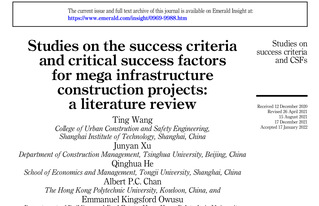摘要
Purpose
This study intends to review studies on the success criteria and critical success factors (CSFs) for mega infrastructure construction projects (MICPs) from journal articles between 2000 and 2018 to (1) identify the publication trend of success criteria and CSFs for MICPs; (2) explore distributions of selected papers, including the distribution of journals, authors’ origin/country and publications by country or region focus; and (3) summarize the findings of success criteria and CSFs studies of MICPs.
Design/methodology/approach
A methodical and systematic analysis of 38 selected journal articles was conducted using descriptive analysis to obtain the annual trend of publications, distributions of publication sources, contributors’ origin/country, regions/countries of research focus, methods involved in publications and thematic analysis to identify and categorize success criteria and CSFs for MICPs.
Findings
Australia, the USA, UK, China and Hong Kong had been the leading contributors for publications on success criteria and CSFs for MICPs; meanwhile, China, Australia and the UK have been the countries of focus for most studies on this specific topic. This review identified 20 success criteria grouped into 5 constructs and 36 CSFs grouped into 5 categories and, respectively, integrated them into two conceptual frameworks. The top five CSFs were adequate resource availability, partnering/relationships with key stakeholders, adequate communication and coordination among related parties, public support or acceptance and clear strategic vision. Three implications, namely, evaluation indicators, relationships between CSFs and the success of MICPs and human-related factors, are highlighted in future research.
Originality/value
The identified success criteria and CSFs provide a basis for evaluating the success possibility of MICPs and serve to identify areas for further improvement. Additionally, the CSFs checklist and framework have been established, which could help to conduct further empirical studies. Finally, the holistic analysis identifies gaps in the body of knowledge, revealing avenues for future research.





